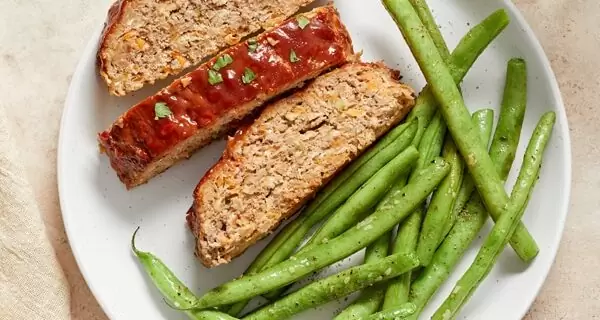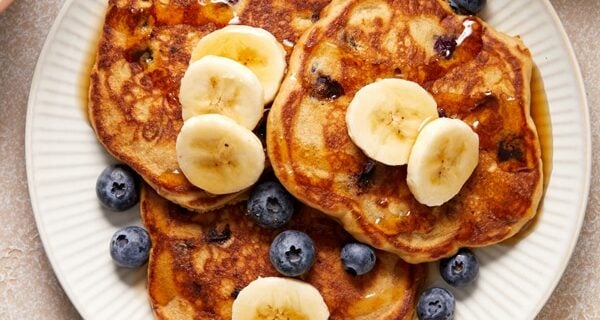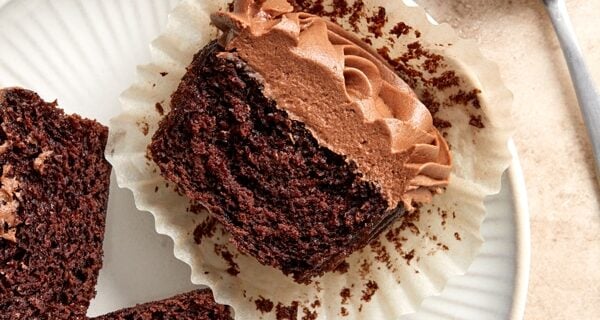Vanilla Bean Sugar Cookies with Royal Icing
These buttery vanilla bean sugar cookies hold their shape perfectly after baking! Filled with dreamy vanilla flavor, they’re a fantastic base for decorating with royal icing or your favorite frosting. Vegetarian.

Note: This recipe is NOT dairy free. It was published before Cook Nourish Bliss transitioned to dairy free recipes and remains popular with long time readers. You can try using substitutions to make it dairy free, however I have not tested this myself and can’t say how it will turn out.
My first attempt at decorating with royal icing did not go as planned. My first mistake was starting the process around 8 o’clock at night. I was already tired and incorrectly thought it wouldn’t take that long.
My next mistake was thinking that I would be awesome at using royal icing even though it was my first try. Forget about that whole practice makes perfect thing.
I gave up around 10 pm. I tried to pipe the outline with icing that was way too thick. Then I tried to flood with icing that was still way too thick. I didn’t even attempt to pipe on details. I was mad. Very mad.
But I kept at it and finally have gotten to the point where the cookies are starting to turn out the way I want them to. I still have a lot to learn but finally feel comfortable sharing my results with you!
Tutorials For Working With Royal Icing
The recipe for both the sugar cookies and royal icing is below, but first I wanted to link to a few tutorials that have helped me work with this kind of icing.
I really wish I had read these before I made my first attempt. Lesson learned.
Everyday Annie – How to decorate with royal icing
Bake at 350 – Royal icing 102
Brown Eyed Baker – How to decorate cookies with royal icing
As a side note, when I first heard about royal icing, I wasn’t really sure what all the fuss was about. But let me tell you, this stuff can make some very beautiful cookies.
It does take some patience and practice, lots of practice. But the end results are so worth it.
And take it from me – if your first attempt doesn’t go so well, don’t worry it will get better!

Additional Cookie Recipes You Might Enjoy:
- Chocolate Cream Cheese Cookies
- Vanilla Chai Shortbread Cookies
- Grandma’s Butter Horns
- Caramel Latte Thumbprint Cookies
Did you make this recipe? Rate and review it down below! I’d love to hear from you.

Vanilla Bean Sugar Cookies with Royal Icing
These buttery vanilla bean sugar cookies hold their shape perfectly after baking! Filled with dreamy vanilla flavor, they’re a fantastic base for decorating with royal icing or your favorite frosting. Vegetarian.
Ingredients
For the sugar cookies:
- 16 tablespoons (2 sticks) unsalted butter, room temperature
- 1 cup confectioners’ sugar
- 1 vanilla bean
- 1 large egg
- 2 ½ teaspoons vanilla extract
- 2 ½ cups all-purpose flour
- ½ teaspoon salt
For the royal icing:
- 4 cups confectioners’ sugar, sifted
- 2 tablespoons meringue powder
- 5 tablespoons water
Instructions
For the sugar cookies:
- Add the butter and sugar to the bowl of a stand mixer fitted with the paddle attachment. Beat on medium-high for about 1 to 2 minutes, until smooth and creamy.
- Split the vanilla bean lengthwise and scrape out the seeds. Add the seeds to the bowl, along with the egg and vanilla extract. Beat until incorporated. Next, add in the flour and salt. Mix on low speed until just combined.
- Form the dough into a ball and cover tightly with plastic wrap. Chill the dough in the refrigerator until firm, about 1 to 2 hours. {I usually make the dough the night before I bake the cookies. It keeps fine in the refrigerator overnight.}
- Preheat your oven to 375ºF. Line a baking sheet with parchment paper and set aside.
- On a well-floured surface, roll out the dough to about ¼ inch in thickness. Cut the dough with cookie cutters and place on the prepared baking sheet.
- Bake for 8 to 10 minutes, rotating halfway through baking. Be sure to remove the cookies when they are completely set, but before they brown around the edges.
- Let cool for several minutes on the baking sheet, then remove to a wire rack to cool completely. Decorate with royal icing (continued below) or your favorite frosting.
For the royal icing:
- Add the sugar, meringue powder and water to the bowl of a stand mixer fitted with the paddle attachment. Mix on low speed for about 7 to 10 minutes, until the icing is no longer shiny (and has a matte appearance).
- Transfer the icing to a container with a tight-fitting lid (tupperware works great). Add in additional water a small bit at a time (¼ to ½ teaspoon) and stir until fully incorporated. You want the icing to be a good consistency for piping. If it seems at all too stiff to pipe a border around the edges of the cookies, add a little more water (if you go too far you can always add additional sifted confectioners’ sugar).
- Once the icing is at the desired consistency, divide into additional containers, depending on how many colors you plan to use. Color the icing at this point. Gel food coloring works best, as it does not add additional liquid to the icing. Make sure to keep your containers covered when not in use. To help reduce air bubbles before piping, let the icing sit for 30 seconds to a minute (you’ll see the bubbles rise to the surface of the container). Stir again and then proceed.
- Transfer some of the icing to a pastry bag fitted with a small tip (I usually use a #3) and pipe around the edges of each cookie. Let the outline set before you flood the cookies. Typically by the time I finish outlining all the cookies, the first ones are ready to flood.
- Set aside some of the icing used for the outlines to pipe on details later (if you plan to do so). Remember to always keep the icing tightly covered when not in use to prevent it from drying out.
- Next, flood the cookies. To do this, slowly add additional water a small bit at a time (again about ¼ to ½ teaspoon) to thin out the icing. It should be thin enough that if you pick up some of the icing with a spoon and let it drizzle back into the container, it incorporates within 5 to 10 seconds. To help reduce air bubbles, let the icing sit for a minute or so (you’ll see the bubbles rise to the surface of the container). Stir again and then proceed. Transfer the icing to a squeeze bottle (or another pastry bag with a small hole cut off the end). Squeeze the icing inside the outline and flood until it almost covers the cookie. Use a toothpick to help the icing reach all the space inside the outline.
- Allow the icing to set completely, at least for several hours. I usually leave them out overnight (do not cover them or run the risk of damaging all your hard work – they won’t dry out).
- Once completely set, use the reserved icing to pipe on details and decorations as desired. Let set completely and then store cookies in an airtight container.
Notes
*Yield will vary widely depending on the size of your cookie cutters.
Cookies adapted from Everyday Annie. Royal icing also adapted from Everyday Annie.
Nutrition Information:
Yield: 25 Serving Size: 1Amount Per Serving: Calories: 204Total Fat: 8gSaturated Fat: 5gTrans Fat: 0gUnsaturated Fat: 3gCholesterol: 27mgSodium: 48mgCarbohydrates: 32gFiber: 0gSugar: 22gProtein: 2g
Nutrition data shown is an estimate provided by an online calculator and is for informational purposes only. It should not be considered a substitute for a medical professional’s advice.




Hi! My dough came out a little on the wet/tacky side. Is that ok?
Hey Brittanie! The dough will be soft fresh from the mixer but should firm up nicely once chilled in the fridge. Was that what you meant?
Hi again! I made these cookies and they are INCREDIBLE! Just wondering if there is a good substitute for the vanilla bean? I know it’s the essence of these cookies, but at $12 per bean near me, I’d like to try something else from time to time!
Oh this made my day! There’s not really a great substitute (vanilla bean paste would also work but that’s expensive too!) … however another option is to omit the vanilla bean (leave the vanilla extract) and then add anywhere from 1/4 to 1/2 teaspoon almond extract. It’s a different flavor but SO GOOD.
How long would you say the cookies stay good before icing? After icing? Trying to figure out how far in advance I can make them. Thank you! I can’t wait to try this recipe!
Hey Whitney! Before icing, I’d say about a day to keep them fresh (I usually make them the day before I plan to decorate). But once covered in the icing, they stay much longer – about one week (if in an airtight container / bag).
Another option would be to bake the cookies off, let cool and then freeze. Then thaw out whenever you’re ready to decorate. Hope that helps!
I am planning to use this idea for a baby shower I am giving for a friend. Where did you find the cookie cutters?
Hi Linda! I found them at Sur la Table. I want to say I’ve seen similar ones at Michael’s a few times but I’m not 100% sure!